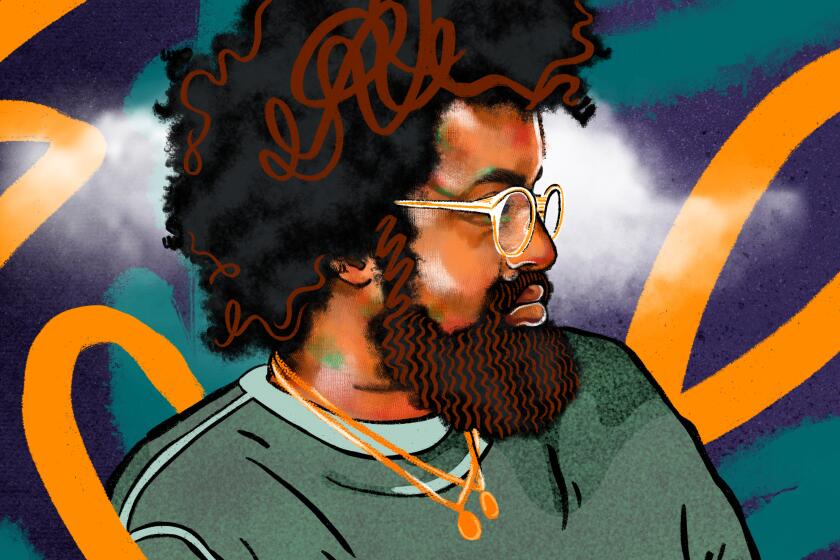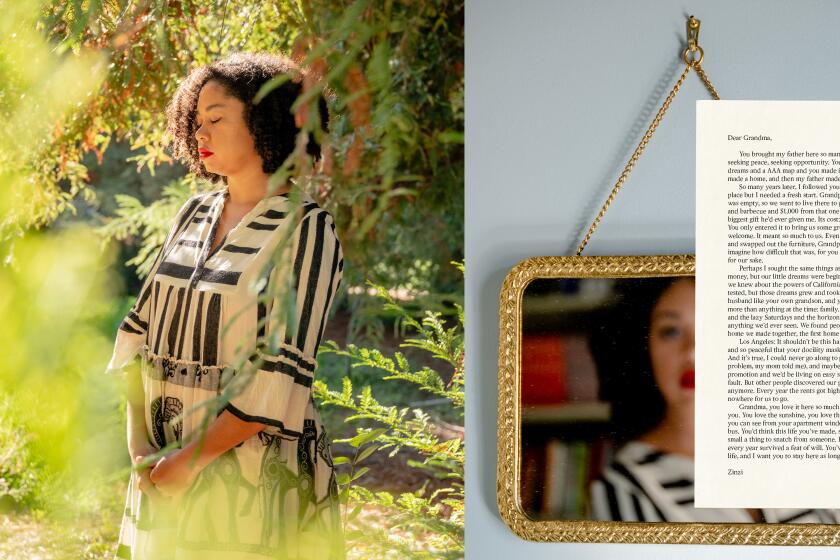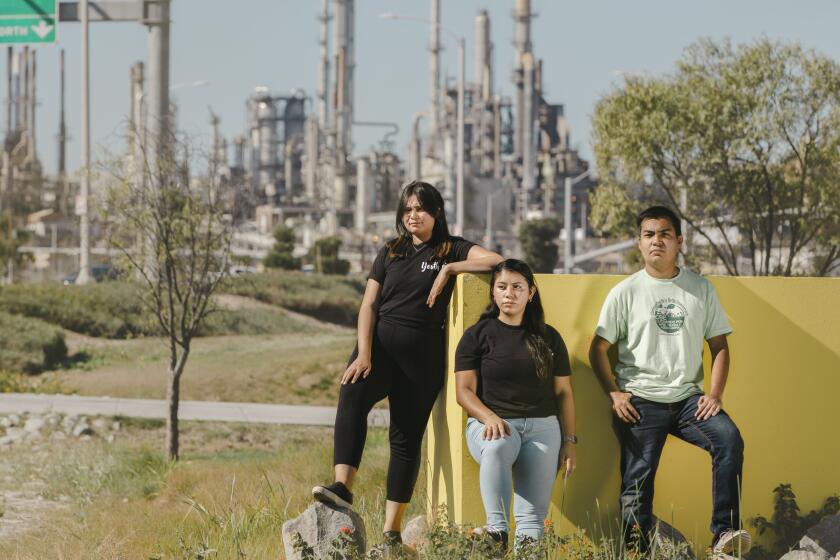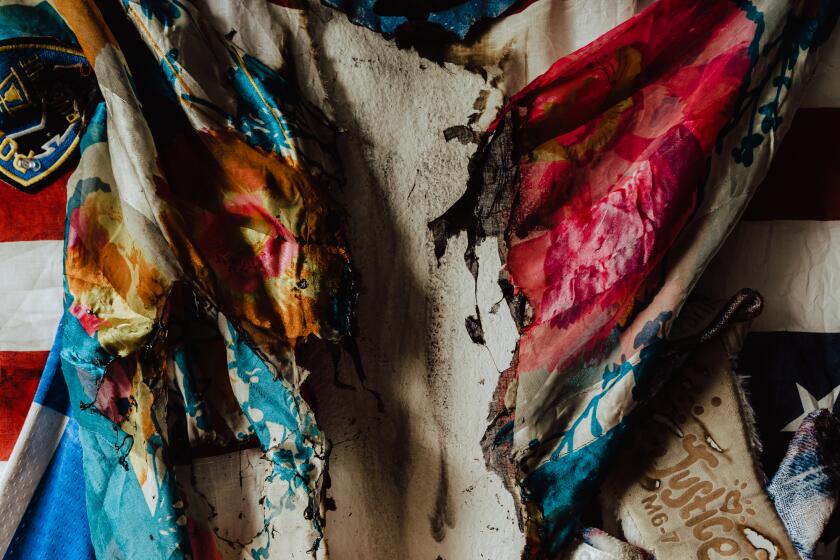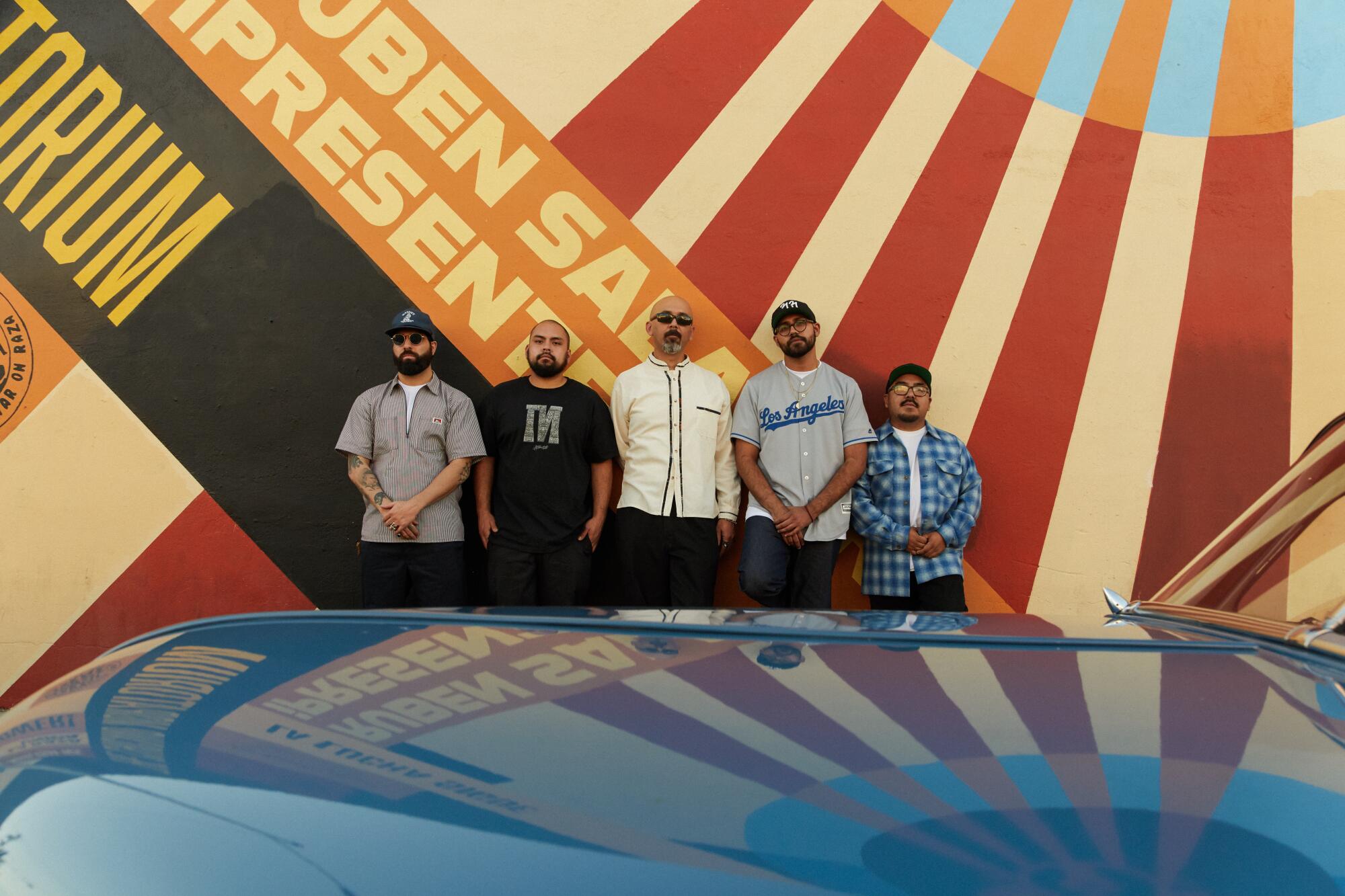
- Share via
This story is part of Image issue 7, “Survival,” a collective vision for the L.A. of our dreams. See the full package here.
“Highways & Byways,” the current exhibition by 3B Collective at Residency Art Gallery in Inglewood, is many things: An exploration of the way megadevelopments like freeways and stadiums displace communities of color. A bridge for understanding the connections between gentrification and environmental issues. A needle threading all of these things back to indigenous traditions and colonization. But more than anything, it’s a reclamation — of the things that lie under the concrete, of L.A.‘s aesthetic traditions, like graffiti and lowrider culture, born from these overlapping histories.
The collective has been sparking these kinds of conversations in its work since it was formed in 2017 by a group of mostly UCLA students. Through murals, public artworks and site-specific installations, 3B has sought to uplift its indigenous, immigrant and Chicano communities while addressing the inequities within them. We spoke with 3B members Oscar Magallanes, Alfredo Diaz, Aaron Estrada, Michael Khosravifard and Gustavo Martinez about the cycles that repeat themselves, the trauma of seeing their neighborhoods change and the ways in which their first L.A. show attempts to make sense of it all, through paintings, photography and sculpture.
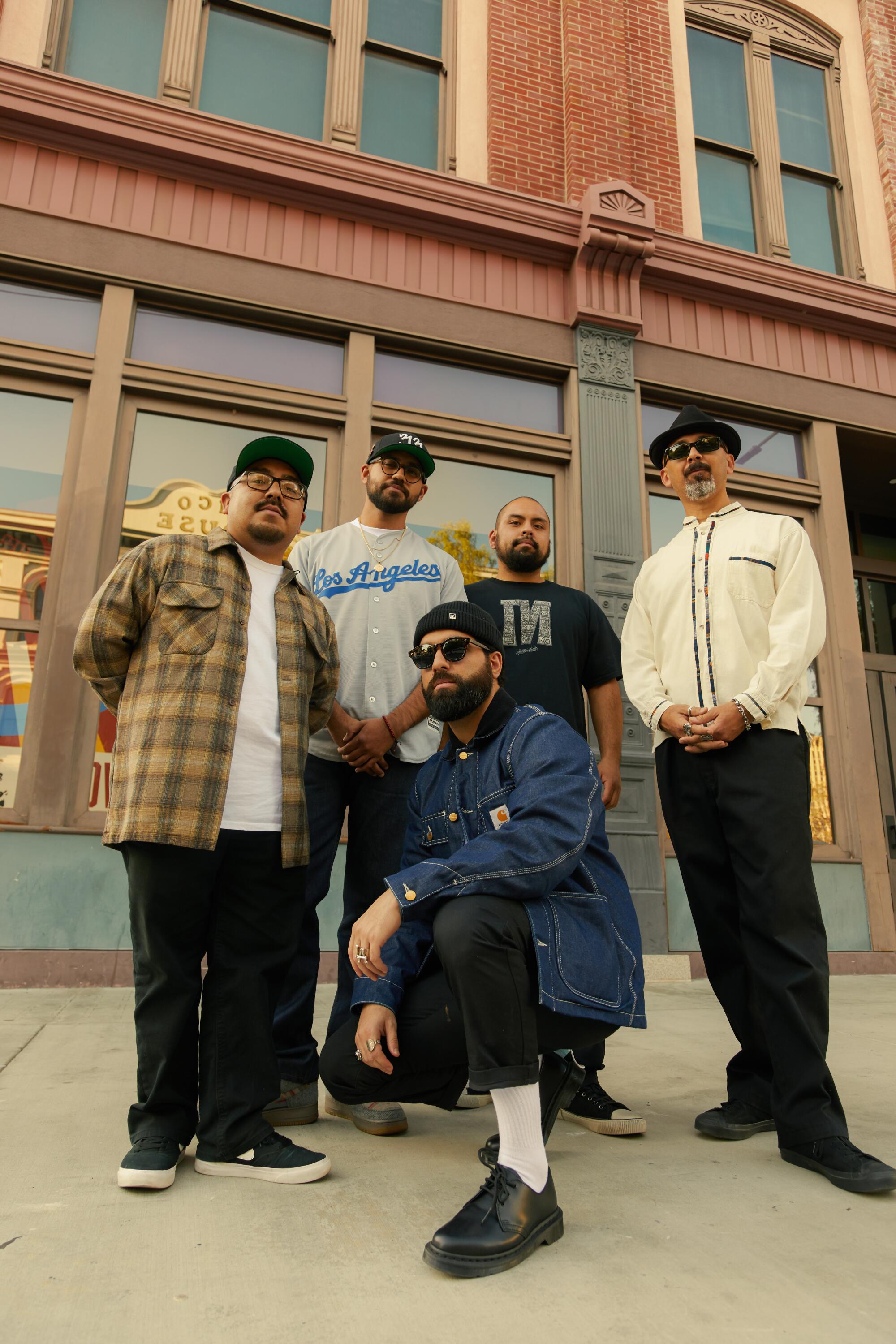
Your work feels very rooted in history while also pointing toward the future. How do you strike that balance?
Aaron Estrada: We make work for ourselves but also the community that we identify [with]. Murals themselves are storytelling, there’s so much history to it. And that’s something that we take into consideration when we do our murals. We always make sure we acknowledged the space that we’re in, we do our research and see what indigenous people were there, what community is there and what’s going on with the environment.
Alfredo Diaz: With this recent show, we were all in the studio together having conversations about what art is and where it’s going. We were trying to negotiate with ourselves what we wanted the work to look like going from murals to paintings. So we’re definitely referencing Chicano history and indigenous history, but instead of it being fully referential, it’s trying to figure out what we want Chicano to look like in 2021 or 2022, and moving [forward].
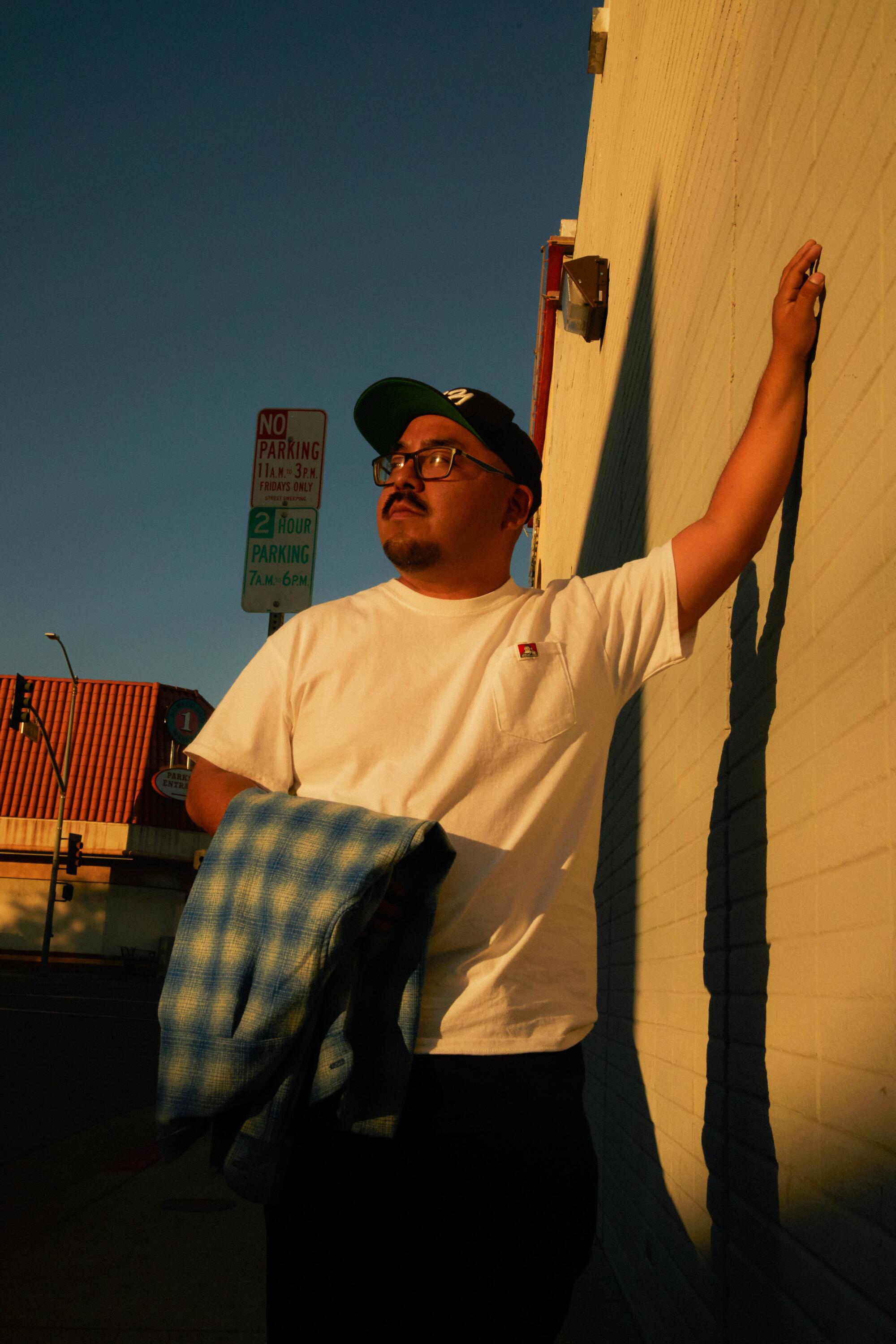
Estrada: We’re always working with imagery and icons from Mesoamerica and we’re trying to figure out how to relate that to what’s going on right now. Sadly, the funny thing is that some of the conversations that we’re having are still going on — about genocide, about Black and brown bodies being discriminated against, systemic racism. We are looking at how it’s essentially carried on to today.
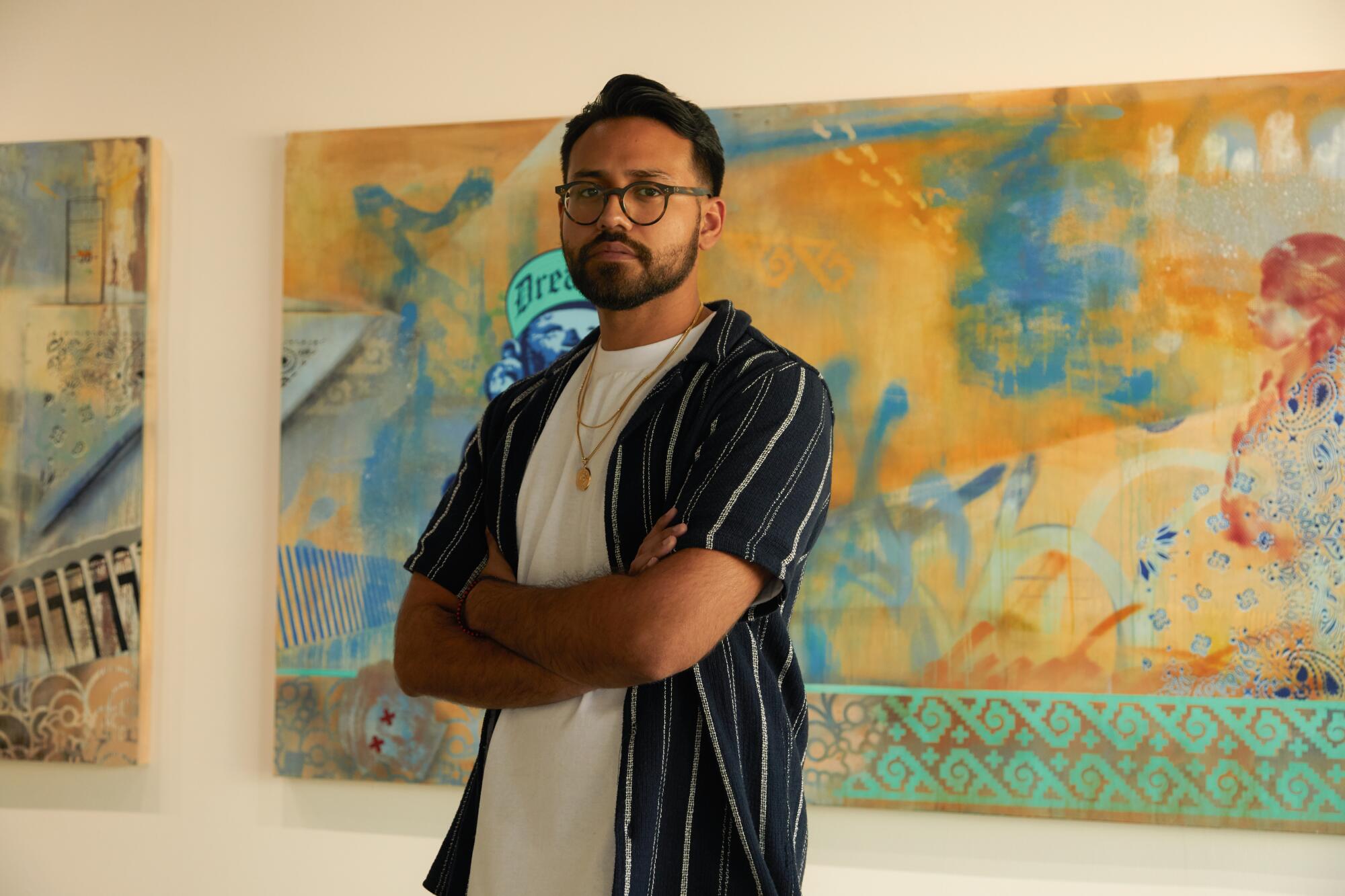
Oscar Magallanes: Just to add to that, these are conversations that we always have, as far as just thinking about time linearly — that’s very much a Eurocentric way of looking at things. Before we would look at cycles, we wouldn’t look at just linear time. Unfortunately everything is connected to colonialism, and so there’s very little difference between the systems that we set up for colonialism and gentrification.
Inside Issue 7: Survival
Writer Rembert Browne investigates the mysterious ailments that just showed up one day
Writer Zinzi Clemmons wants you to be able to stay in the city as long as you want
Journalist Cerise Castle pays tribute to the city’s forgotten site of refuge and devastation
Gypsy Sport designer and creative director Rio Uribe sees a future where eco-friendly won’t be slept on
Actor and activist Kendrick Sampson knows that faith and organizing infrastructure in L.A. will get us through
How does “Highways & Byways” draw from your own experience growing up?
Gustavo Martinez: I grew up in the byways, those sort of routes around the city. One of the main ones was the train. I started documenting gentrification in Inglewood around 2010 or 2011: I continued to map out space and return to the same places to rephotograph them. But during college is when I really saw the transition of how the train tracks that were unusable were going to be switched over to the Metro. And once the Metro started to be developed, that’s when I realized, “This is going to completely shift my neighborhood, which eventually displaces me.”
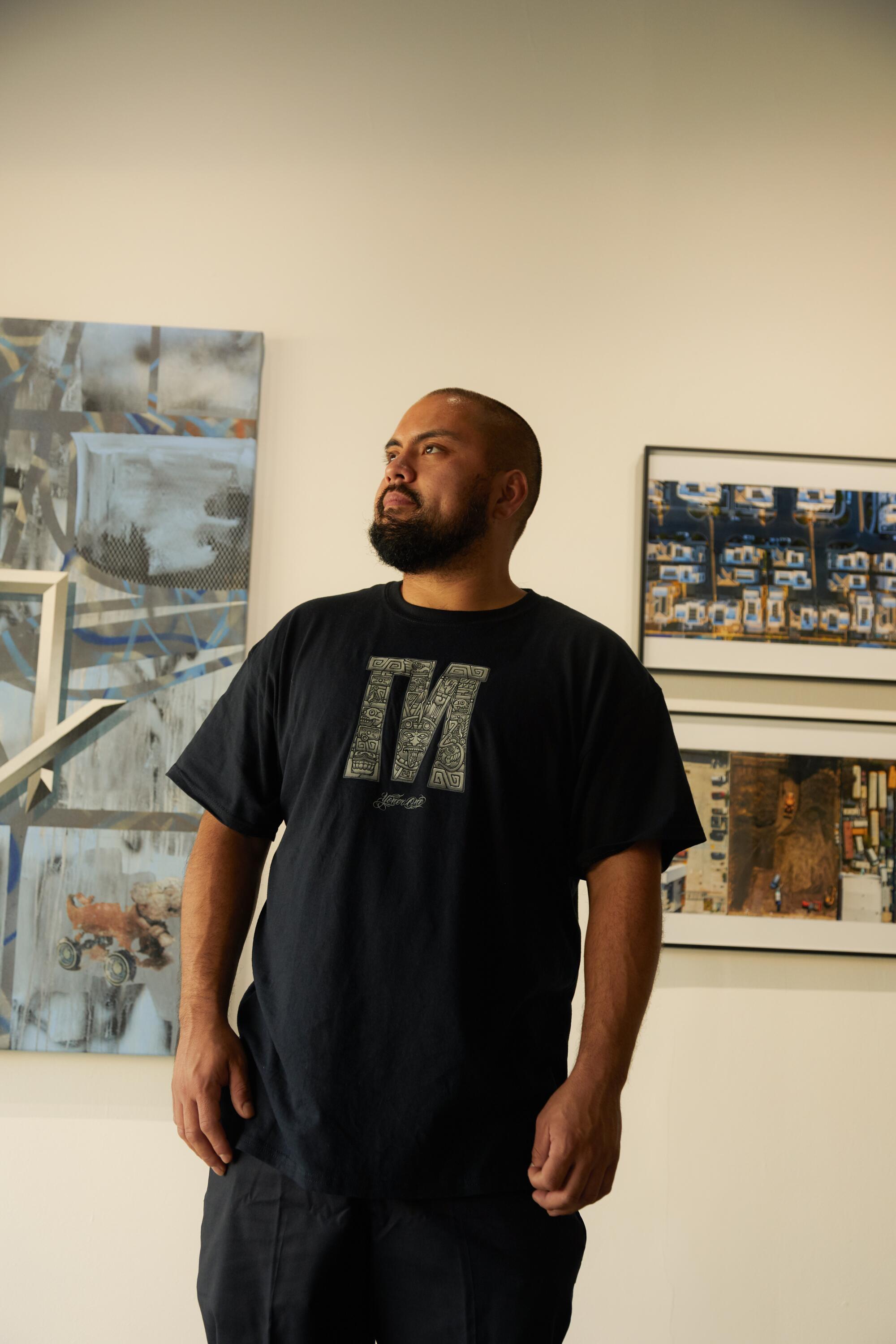
Now I live in South L.A., in Westmont, and I’m seeing how Westmont is just like Inglewood was 10 or 15 years before. I can see the cycle of how the border of where Inglewood and South L.A. are going to shift over and just continue to sort of eat up the city and just sort of continue to raise the rent and displace people.
Diaz: I grew up in South Central where a lot of the neighborhoods were defined by the freeways. I had cousins who were on the east side of the 110. I was on the west side of the 110. That’s sort of how we identified with each other, and that’s how you started to recognize symbols, sign languages and these writings on walls. You learn how to decode your neighborhood through those systems. For me, in the last decade, [the areas] started to shift into places that have like $800 million homes, even in South Central.
Estrada: I grew up in downtown, Pico-Union. Downtown was a place that no one really wanted to be associated with because there was the stigma of skid row being dangerous. As more big businesses started to come in and gentrify all of Broadway, seeing that happen, it was traumatizing honestly. I think it’s visible in our work: Seeing the different layers of how we tried to hold on to something that was, whether it’s through icons or certain writings on the wall, sign paintings or just murals, seeing that washed away by a corporation, it’s just terrible.
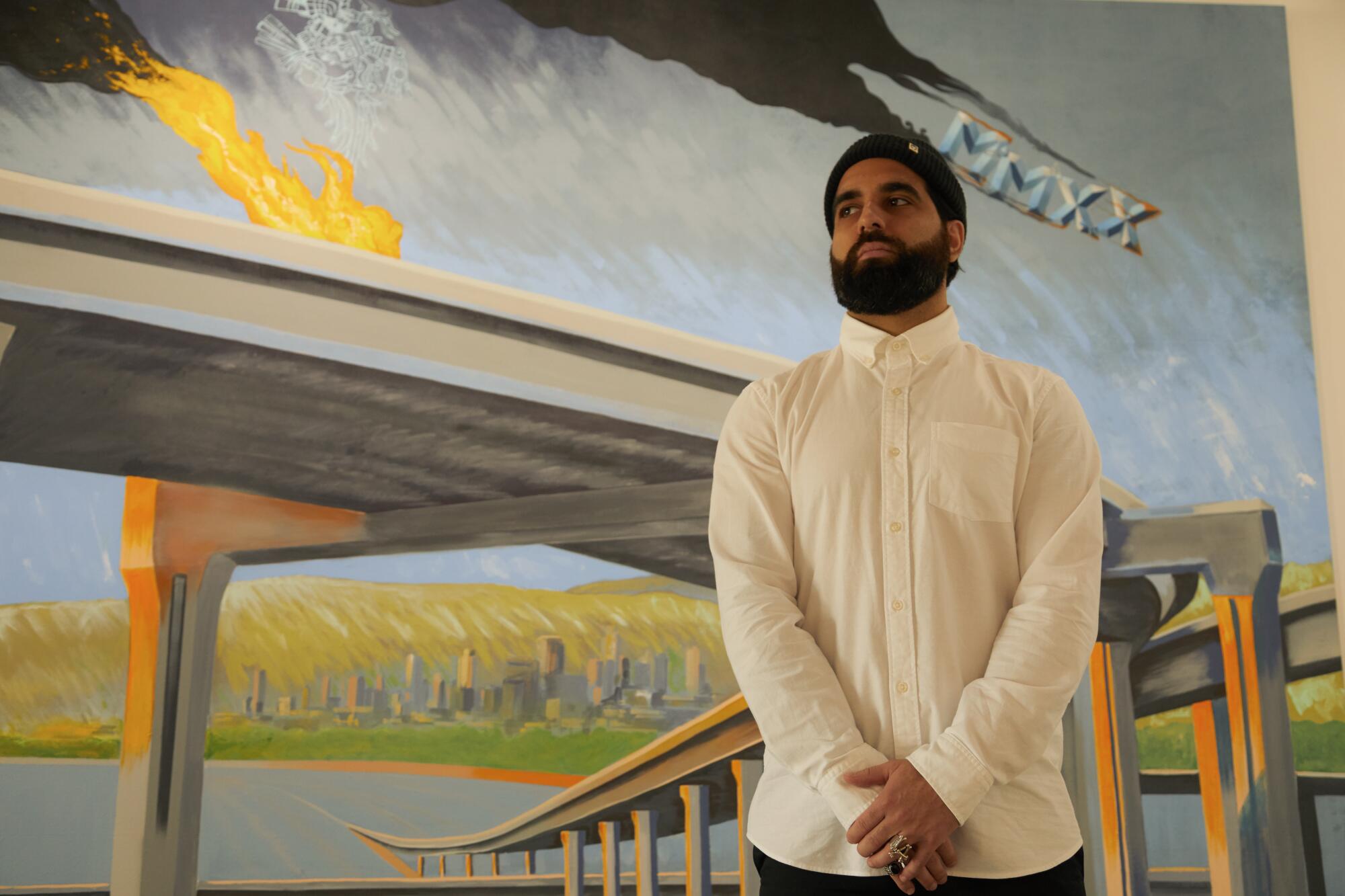
Michael Khosravifard: I’m actually not from Los Angeles, I’m from Sacramento. But I feel like there’s a lot of symbolism with the freeways in Los Angeles. Art is not a really accessible thing for people who come from marginalized communities, and the highways are almost like a canvas — it’s really symbolic. For a lot of artists, this is where they’re taking their art. This is their first interaction with it.
Diaz: For us, “Highways & Byways” was a taking-off point to talk about what these structures do to us, or what they do to our communities. And like Michael was talking about, that these are canvases and we sort of take that in stride and take what’s stomped down on us and turn it into something that we visually conquer in a way. What I take away from the body of work is looking at these structures differently, through our lens, through our collective lens. Because we’re not referencing culture, we are culture, so we need to take charge of that and drive it into where we want it to go.
Tell me about how the show builds that connection between gentrification and the major climate issues happening.
When Rembert Browne is overtaken by the sudden onset of strange ailments, all he knows is that something’s off. Is it anxiety? A serious illness? He’s not sure.
Magallanes: What’s happened in our own communities from the freeways to these battery plants — these are environmental issues, these are things that are completely tied back to extracting some kind of resource, which then goes back to colonialism. These are all conversations that we have, and they’re difficult to have, especially when we start thinking about it in an aesthetic form. How do we tell these stories? It’s extremely complicated.
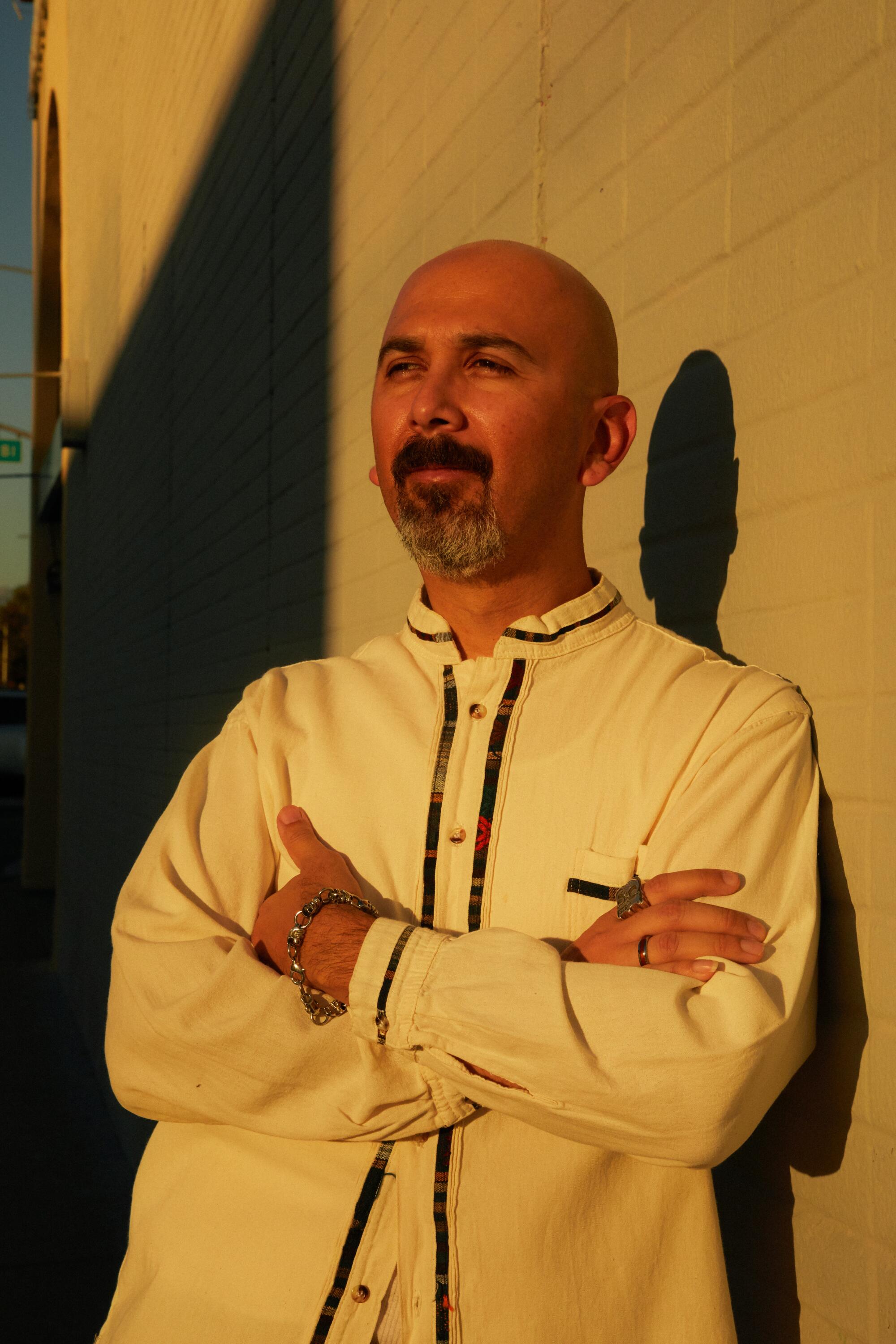
Estrada: Gentrification is a climate issue. Gentrification affects the body’s environment. Essentially, what gentrification does is displace bodies, displace people from their homes. [It’s] also essentially creating tension and bringing new dynamics to neighborhoods, creating internal warfare between certain areas. Growing up next to freeways ... the exhaust that gets breathed in. Over time, it’s going to take a toll on our bodies.
Martinez: I also think about it in reference to how a lot of crime happens close to freeways. A lot of low-income neighborhoods live close to freeways — specifically, South Central L.A. is dissected by the 110 freeway — and high crime causes health issues. So it can be physically bad for your body but also mentally traumatic.
Diaz: Just to point to the actual work that’s up — there’s an image of Tlaloc, which is the [Aztec] symbol for [and god of] water, and it’s sort of falling onto the freeway. We’re speaking to the importance of water and the importance of the environment, because indigenous people were the most connected to the earth in history.
This is where colonialism takes off. [Colonizers] came to a wild space that was very much calculated: The trees were there for a reason, the plants were there for a reason. When they came in and started to take over this and take over that, they found themselves looking around after they destroyed everything and wondered why things weren’t growing anymore, or why things weren’t happening for them. And I think now, you know, coming back to the present where gentrification we’re talking about, and know the importance of our environment.
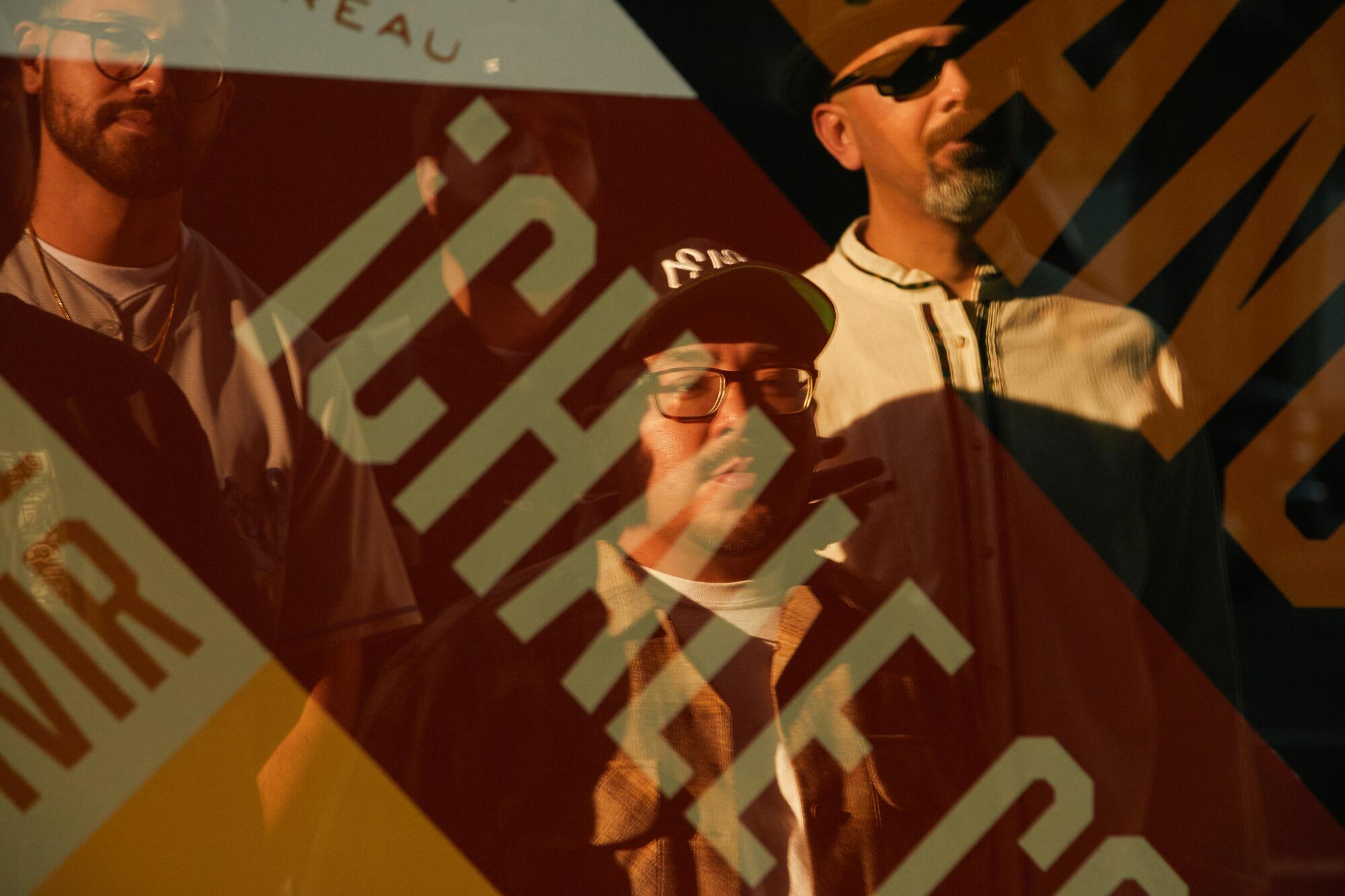
What does “Highways & Byways” teach us — about megastructures, the future, the past, ourselves?
Magallanes: It makes these connections. Whether it was 50 years ago, or 100 years ago, or 200 years ago, there’s cycles to this. Freeways were marketed as a way to demarcate communities — that’s what came up in the research for the show. You could tell what they were doing.
Diaz: Going back to what these structures mean and how we are using it in our work, it’s a great conversation about what structures are here now and then what we want to do to address it. And to transform it into something that looks visually enticing. Because it has to look good. For us, it has to .
Estrada: L.A. is always growing. It’s a young city but there’s so much history. The show itself layers [these] different histories. It’s important to document the voices we relate to, because typically we don’t have people to speak for us. Sometimes it’s not even about having someone to speak for you but just having someone be there for you. The work is essentially like a family member. I like to view them as family members, because when we’re interacting together, we’re putting our emotion into it, we’re having a conversation about what makes sense with the work, what doesn’t make sense with the work. So essentially, we’re giving so much to it.
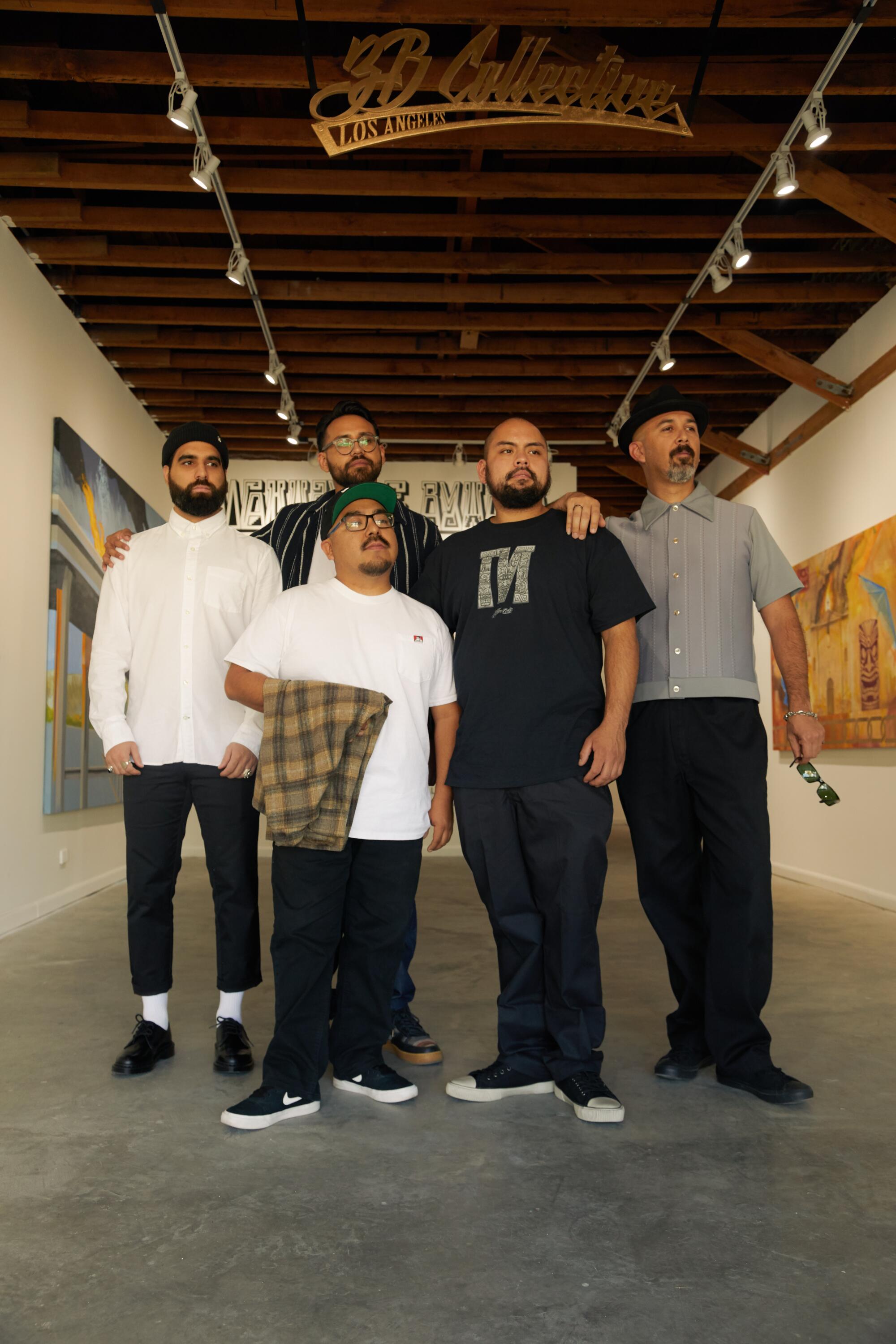
What does the future like?
Diaz: To tap into that cyclicality, you know, what the future looks like for us: I think we can agree that it looks collective.

